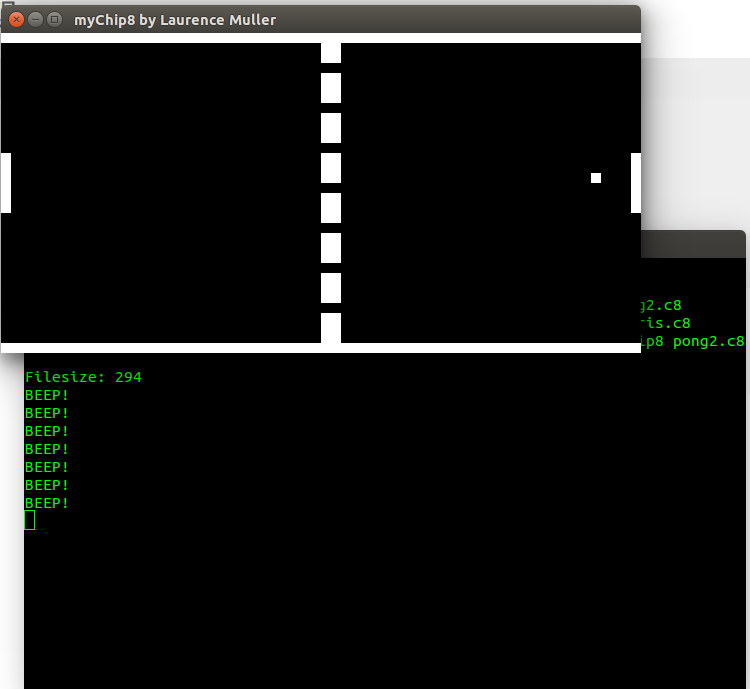在完成了CHIP8的核心实现后,剩下的事情就是完成画面和输入。为了逻辑区分不干扰,这一部分代码放在main.c函数中实现。其实这部分因为有关GLUT的应用,我也不是太了解,因为我的重点不是放在这上面,所以所做的就是把参考源码依瓢画葫芦,最终实现了CHIP8.
关于GLUT,首先你要进行安装,这里给出Linux下的安装方式GLUT安装
GLUT教程,网上找到了两个,一个是翻译了一部分的,一个原教程。看了以后,main.c中的代码就很容易理解了。对GLUT有兴趣的可以参考下面教程进行深入了解。
main.c代码:
#include <stdio.h>
#include <GL/glut.h>
#include "mychip8.h"
// Display size
#define SCREEN_WIDTH 64
#define SCREEN_HEIGHT 32
int modifier = 10;
// Window size
// int display_width = SCREEN_WIDTH * modifier;
// int display_height = SCREEN_HEIGHT * modifier;
int display_width = 640;
int display_height = 320;
void display();
void reshape_window(GLsizei w, GLsizei h);
void keyboardUp(unsigned char key, int x, int y);
void keyboardDown(unsigned char key, int x, int y);
// Use new drawing method
#define DRAWWITHTEXTURE
//typedef unsigned __int8 u8;
unsigned char screenData[SCREEN_HEIGHT][SCREEN_WIDTH][3];
void setupTexture();
int main(int argc, char **argv)
{
if(argc < 2)
{
printf("Usage: myChip8.exe chip8application\n\n");
return 1;
}
// Load game
if(!LoadApp(argv[1]))
return 1;
// Setup OpenGLabclixu123
glutInit(&argc, argv);
glutInitDisplayMode(GLUT_DOUBLE | GLUT_RGBA);
glutInitWindowSize(display_width, display_height);
glutInitWindowPosition(320, 320);
glutCreateWindow("myChip8 by Laurence Muller");
glutDisplayFunc(display);
glutIdleFunc(display);
glutReshapeFunc(reshape_window);
glutKeyboardFunc(keyboardDown);
glutKeyboardUpFunc(keyboardUp);
#ifdef DRAWWITHTEXTURE
setupTexture();
#endif
glutMainLoop();
return 0;
}
// Setup Texture
void setupTexture()
{
int x, y;
// Clear screen
for(y = 0; y < SCREEN_HEIGHT; ++y)
for(x = 0; x < SCREEN_WIDTH; ++x)
screenData[y][x][0] = screenData[y][x][1] = screenData[y][x][2] = 0;
// Create a texture
glTexImage2D(GL_TEXTURE_2D, 0, 3, SCREEN_WIDTH, SCREEN_HEIGHT, 0, GL_RGB, GL_UNSIGNED_BYTE, (GLvoid*)screenData);
// Set up the texture
glTexParameteri(GL_TEXTURE_2D, GL_TEXTURE_MAG_FILTER, GL_NEAREST);
glTexParameteri(GL_TEXTURE_2D, GL_TEXTURE_MIN_FILTER, GL_NEAREST);
glTexParameteri(GL_TEXTURE_2D, GL_TEXTURE_WRAP_S, GL_CLAMP);
glTexParameteri(GL_TEXTURE_2D, GL_TEXTURE_WRAP_T, GL_CLAMP);
// Enable textures
glEnable(GL_TEXTURE_2D);
}
void updateTexture()
{
int x, y;
// Update pixels
for( y = 0; y < 32; ++y)
for( x = 0; x < 64; ++x)
if(Gfx[(y * 64) + x] == 0)
screenData[y][x][0] = screenData[y][x][1] = screenData[y][x][2] = 0; // Disabled
else
screenData[y][x][0] = screenData[y][x][1] = screenData[y][x][2] = 255; // Enabled
// Update Texture
glTexSubImage2D(GL_TEXTURE_2D, 0 ,0, 0, SCREEN_WIDTH, SCREEN_HEIGHT, GL_RGB, GL_UNSIGNED_BYTE, (GLvoid*)screenData);
glBegin( GL_QUADS );
glTexCoord2d(0.0, 0.0); glVertex2d(0.0, 0.0);
glTexCoord2d(1.0, 0.0); glVertex2d(display_width, 0.0);
glTexCoord2d(1.0, 1.0); glVertex2d(display_width, display_height);
glTexCoord2d(0.0, 1.0); glVertex2d(0.0, display_height);
glEnd();
}
// Old gfx code
void drawPixel(int x, int y)
{
glBegin(GL_QUADS);
glVertex3f((x * modifier) + 0.0f, (y * modifier) + 0.0f, 0.0f);
glVertex3f((x * modifier) + 0.0f, (y * modifier) + modifier, 0.0f);
glVertex3f((x * modifier) + modifier, (y * modifier) + modifier, 0.0f);
glVertex3f((x * modifier) + modifier, (y * modifier) + 0.0f, 0.0f);
glEnd();
}
void updateQuads()
{
int x, y;
// Draw
for( y = 0; y < 32; ++y)
for( x = 0; x < 64; ++x)
{
if(Gfx[(y*64) + x] == 0)
glColor3f(0.0f,0.0f,0.0f);
else
glColor3f(1.0f,1.0f,1.0f);
drawPixel(x, y);
}
}
void display()
{
HandleOpcode();
if(DrawFlag)
{
// Clear framebuffer
glClear(GL_COLOR_BUFFER_BIT);
#ifdef DRAWWITHTEXTURE
updateTexture();
#else
updateQuads();
#endif
// Swap buffers!
glutSwapBuffers();
// Processed frame
DrawFlag = 0;
}
}
void reshape_window(GLsizei w, GLsizei h)
{
glClearColor(0.0f, 0.0f, 0.5f, 0.0f);
glMatrixMode(GL_PROJECTION);
glLoadIdentity();
gluOrtho2D(0, w, h, 0);
glMatrixMode(GL_MODELVIEW);
glViewport(0, 0, w, h);
// Resize quad
display_width = w;
display_height = h;
}
void keyboardDown(unsigned char key, int x, int y)
{
if(key == 27) // esc
;//exit(0);
if(key == '1') Keyboard[0x1] = 1;
else if(key == '2') Keyboard[0x2] = 1;
else if(key == '3') Keyboard[0x3] = 1;
else if(key == '4') Keyboard[0xC] = 1;
else if(key == 'q') Keyboard[0x4] = 1;
else if(key == 'w') Keyboard[0x5] = 1;
else if(key == 'e') Keyboard[0x6] = 1;
else if(key == 'r') Keyboard[0xD] = 1;
else if(key == 'a') Keyboard[0x7] = 1;
else if(key == 's') Keyboard[0x8] = 1;
else if(key == 'd') Keyboard[0x9] = 1;
else if(key == 'f') Keyboard[0xE] = 1;
else if(key == 'z') Keyboard[0xA] = 1;
else if(key == 'x') Keyboard[0x0] = 1;
else if(key == 'c') Keyboard[0xB] = 1;
else if(key == 'v') Keyboard[0xF] = 1;
//printf("Press key %c\n", key);
}
void keyboardUp(unsigned char key, int x, int y)
{
if(key == '1') Keyboard[0x1] = 0;
else if(key == '2') Keyboard[0x2] = 0;
else if(key == '3') Keyboard[0x3] = 0;
else if(key == '4') Keyboard[0xC] = 0;
else if(key == 'q') Keyboard[0x4] = 0;
else if(key == 'w') Keyboard[0x5] = 0;
else if(key == 'e') Keyboard[0x6] = 0;
else if(key == 'r') Keyboard[0xD] = 0;
else if(key == 'a') Keyboard[0x7] = 0;
else if(key == 's') Keyboard[0x8] = 0;
else if(key == 'd') Keyboard[0x9] = 0;
else if(key == 'f') Keyboard[0xE] = 0;
else if(key == 'z') Keyboard[0xA] = 0;
else if(key == 'x') Keyboard[0x0] = 0;
else if(key == 'c') Keyboard[0xB] = 0;
else if(key == 'v') Keyboard[0xF] = 0;
}上述代码需要注意的是原作者给出了两种绘图方式。还有关于CHIP8的键盘,映射方式如下:
Keypad Keyboard
+-+-+-+-+ +-+-+-+-+
|1|2|3|C| |1|2|3|4|
+-+-+-+-+ +-+-+-+-+
|4|5|6|D| |Q|W|E|R|
+-+-+-+-+ => +-+-+-+-+
|7|8|9|E| |A|S|D|F|
+-+-+-+-+ +-+-+-+-+
|A|0|B|F| |Z|X|C|V|
+-+-+-+-+ +-+-+-+-+最后编译生成可执行代码,然后运行游戏应用
./mychip8 pong2.c8这是一个打乒乓的游戏,运行效果如下,如果没有接着球的话,命令终端就会打印出BEEP!























 8412
8412

 被折叠的 条评论
为什么被折叠?
被折叠的 条评论
为什么被折叠?








